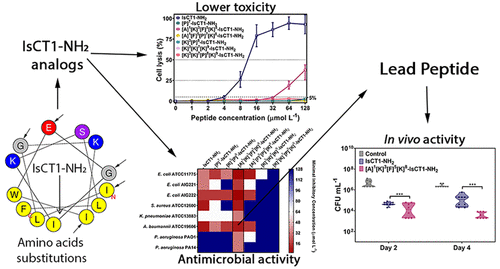当前位置:
X-MOL 学术
›
ACS Infect. Dis.
›
论文详情
Our official English website, www.x-mol.net, welcomes your
feedback! (Note: you will need to create a separate account there.)
Synthetic Peptide Derived from Scorpion Venom Displays Minimal Toxicity and Anti-infective Activity in an Animal Model
ACS Infectious Diseases ( IF 4.0 ) Pub Date : 2021-08-31 , DOI: 10.1021/acsinfecdis.1c00261 Cyntia Silva Oliveira 1 , Marcelo Der Torossian Torres 2, 3, 4 , Cibele Nicolaski Pedron 1 , Viviane Brito Andrade 5 , Pedro Ismael Silva 6 , Fernanda Dias Silva 5 , Cesar de la Fuente-Nunez 2, 3, 4 , Vani Xavier Oliveira 1, 5
ACS Infectious Diseases ( IF 4.0 ) Pub Date : 2021-08-31 , DOI: 10.1021/acsinfecdis.1c00261 Cyntia Silva Oliveira 1 , Marcelo Der Torossian Torres 2, 3, 4 , Cibele Nicolaski Pedron 1 , Viviane Brito Andrade 5 , Pedro Ismael Silva 6 , Fernanda Dias Silva 5 , Cesar de la Fuente-Nunez 2, 3, 4 , Vani Xavier Oliveira 1, 5
Affiliation

|
Multidrug-resistant bacteria represent a global health problem increasingly leading to infections that are untreatable with our existing antibiotic arsenal. Therefore, it is critical to identify novel effective antimicrobials. Venoms represent an underexplored source of potential antibiotic molecules. Here, we engineered a peptide (IsCT1-NH2) derived from the venom of the scorpion Opisthacanthus madagascariensis, whose application as an antimicrobial had been traditionally hindered by its high toxicity. Through peptide design and the knowledge obtained in preliminary studies with single and double-substituted analogs, we engineered IsCT1 derivatives with multiple amino acid substitutions to assess the impact of net charge on antimicrobial activity and toxicity. We demonstrate that increased net charge (from +3 to +6) significantly reduced toxicity toward human erythrocytes. Our lead synthetic peptide, [A]1[K]3[F]5[K]8-IsCT1-NH2 (net charge of +4), exhibited increased antimicrobial activity against Gram-negative and Gram-positive bacteria in vitro and enhanced anti-infective activity in a mouse model. Mechanism of action studies revealed that the increased antimicrobial activity of our lead molecule was due, at least in part, to its enhanced ability to permeabilize the outer membrane and depolarize the cytoplasmic membrane. In summary, we describe a simple method based on net charge tuning to turn highly toxic venom-derived peptides into viable therapeutics.
中文翻译:

源自蝎毒的合成肽在动物模型中显示出最小的毒性和抗感染活性
多重耐药菌是一个全球性的健康问题,越来越多地导致我们现有的抗生素库无法治愈的感染。因此,确定新的有效抗菌剂至关重要。毒液代表了潜在抗生素分子的未充分探索的来源。在这里,我们设计了一种肽 (IsCT1-NH 2 ),它来源于蝎子Opisthacanthus madagascariensis的毒液,其作为抗菌剂的应用传统上因其高毒性而受到阻碍。通过肽设计和在单取代和双取代类似物的初步研究中获得的知识,我们设计了具有多个氨基酸取代的 IsCT1 衍生物,以评估净电荷对抗菌活性和毒性的影响。我们证明增加的净电荷(从 +3 到 +6)显着降低了对人类红细胞的毒性。我们的先导合成肽 [A] 1 [K] 3 [F] 5 [K] 8 -IsCT1-NH 2(+4 的净电荷)在体外对革兰氏阴性菌和革兰氏阳性菌表现出增强的抗菌活性并增强了小鼠模型中的抗感染活性。作用机制研究表明,我们的先导分子的抗菌活性增加,至少部分是由于其增强的外膜通透性和细胞质膜去极化能力。总之,我们描述了一种基于净电荷调整的简单方法,将剧毒的毒液衍生肽转化为可行的治疗方法。
更新日期:2021-09-10
中文翻译:

源自蝎毒的合成肽在动物模型中显示出最小的毒性和抗感染活性
多重耐药菌是一个全球性的健康问题,越来越多地导致我们现有的抗生素库无法治愈的感染。因此,确定新的有效抗菌剂至关重要。毒液代表了潜在抗生素分子的未充分探索的来源。在这里,我们设计了一种肽 (IsCT1-NH 2 ),它来源于蝎子Opisthacanthus madagascariensis的毒液,其作为抗菌剂的应用传统上因其高毒性而受到阻碍。通过肽设计和在单取代和双取代类似物的初步研究中获得的知识,我们设计了具有多个氨基酸取代的 IsCT1 衍生物,以评估净电荷对抗菌活性和毒性的影响。我们证明增加的净电荷(从 +3 到 +6)显着降低了对人类红细胞的毒性。我们的先导合成肽 [A] 1 [K] 3 [F] 5 [K] 8 -IsCT1-NH 2(+4 的净电荷)在体外对革兰氏阴性菌和革兰氏阳性菌表现出增强的抗菌活性并增强了小鼠模型中的抗感染活性。作用机制研究表明,我们的先导分子的抗菌活性增加,至少部分是由于其增强的外膜通透性和细胞质膜去极化能力。总之,我们描述了一种基于净电荷调整的简单方法,将剧毒的毒液衍生肽转化为可行的治疗方法。











































 京公网安备 11010802027423号
京公网安备 11010802027423号